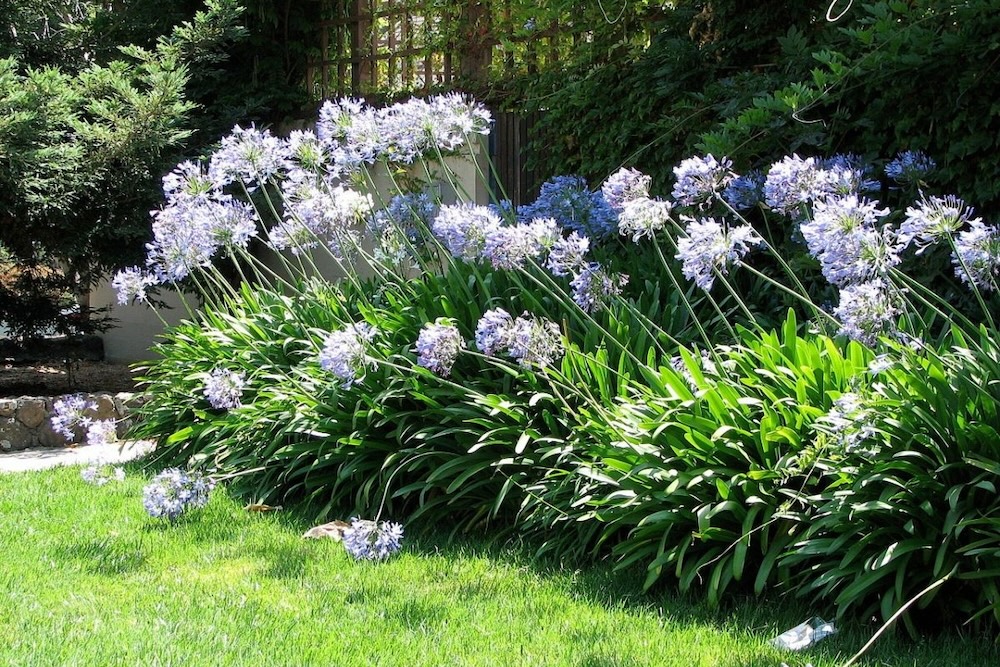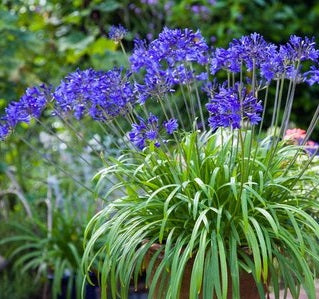Agapanthus Buddy Plants: Perfect Pairings for Your Yard
Agapanthus Buddy Plants: Perfect Pairings for Your Yard
Blog Article
Releasing the Secret to Effective Agapanthus Farming: Tips and Techniques for a Flourishing Garden
In the realm of horticulture, cultivating agapanthus efficiently requires a calculated method that encompasses numerous elements of plant treatment. With mindful focus to detail, one can unlock the tricks to supporting these sensational blossoms, bring about a yard that thrives with beauty and vibrancy. By recognizing the nuances of agapanthus cultivation, one can develop an environment where these plants grow and flower abundantly. In the adhering to conversation, we will certainly discover important tips and tricks that will assist you towards a prospering agapanthus garden, using understandings into best practices, soil problems, sprinkling methods, and more.
Growing Agapanthus: Best Practices
When planting Agapanthus, proper dirt prep work is important for guaranteeing effective growth and growth of these lovely blossoms. Agapanthus, commonly understood as Lily of the Nile or African lily, grows in well-draining soil with a somewhat acidic to neutral pH level - Agapanthus. Prior to growing, it is crucial to amend hefty clay soils with raw material such as garden compost or peat moss to improve water drainage and offer necessary nutrients for the plants
To grow Agapanthus, choose a place that gets complete sunshine to partial color, as this will certainly advertise healthy and balanced development and plentiful flowering. Dig an opening two times the size of the plant's origin round and position the Agapanthus at the same depth it was formerly expanding. Carefully backfill the hole with soil, pushing down strongly to remove any type of air pockets around the origins.
Water the newly planted Agapanthus thoroughly and proceed to keep the soil evenly wet, specifically during the plant's energetic expanding period. Agapanthus. Using a balanced fertilizer once a month can even more support the plant's development and blooming. By adhering to these finest methods for growing Agapanthus, you can develop a spectacular display screen of these exciting flowers in your yard
Ideal Soil Issues for Agapanthus
For optimal growth and growing success of Agapanthus plants, making certain the dirt problems are suitable is crucial. Agapanthus likes soil that is rich in nutrients, so incorporating a well balanced fertilizer throughout the growing period can promote healthy development and dynamic blossoms.

Watering and Feeding Tips
To make certain healthy and balanced development and vivid blossoms, correct watering and feeding strategies are crucial for effective Agapanthus farming. Agapanthus plants gain from routine watering, particularly throughout the expanding season. It is suggested to water deeply as soon as a week, making certain the dirt is moist however not saturated. Throughout hot climate or in pots, more constant watering might be required to prevent the dirt from drying entirely.
When it involves feeding Agapanthus, a balanced plant food with equivalent parts nitrogen, phosphorus, and potassium can be applied in the springtime to advertise healthy and balanced growth and flowering. Slow-release fertilizers are perfect for offering nutrients gradually over an extended duration. Stay clear of over-fertilizing, as this can cause excessive vegetation growth at the expenditure of flowers.
Additionally, including natural issue like compost right into the soil can boost nutrient levels and boost soil framework, helping in the general health of the Agapanthus plants. By complying with these watering and fertilizing pointers, gardeners can guarantee their Agapanthus plants prosper and produce magnificent screens of flowers.
Pruning and Deadheading Strategies
Proper trimming and deadheading techniques play a critical role in preserving the health and wellness and visual appeals of Agapanthus plants, enhancing the necessary practices of watering and feeding for effective cultivation. Trimming Agapanthus involves eliminating invested flower heads, dead or yellowing leaves, and general shaping of the plant to advertise much better development. Deadheading, the process of removing discolored flowers, not just enhances the plant's look but likewise encourages additional flowering.
When deadheading Agapanthus, it is a good idea to snip off the flower stem at the base making use of sharp, tidy shears. This procedure redirects the plant's energy from seed manufacturing back right into root and foliage development, advertising a much healthier and more robust plant. Routine deadheading can extend the flowering period of Agapanthus and protect against self-seeding, which can result in congestion.
In regards to pruning, Agapanthus typically gain from a light trim after blossoming to clean the plant and motivate fresh growth. Reducing the spent flower stems and eliminating any type of dead or damaged foliage assists preserve the plant's vitality and general look. Nevertheless, it is important to prevent Click This Link reducing into the crown of the plant, as this can damage its health.

Protecting Agapanthus From Vermins and Diseases
Carrying out reliable parasite and condition pop over to this site administration techniques is essential to securing the health and wellness and vitality of Agapanthus plants in farming. Agapanthus are normally hardy plants, yet they can still succumb various parasites and conditions otherwise effectively looked after. One typical bug that impacts Agapanthus is the Agapanthus borer, a caterpillar that passages into the plant, creating damage to the fallen leaves and blossoms. To avoid infestations, regular inspection of the plants is necessary. If borers are discovered, they can be manually removed, or insecticidal soap can be used as a control action.
Along with parasites, Agapanthus are vulnerable to conditions such as origin rot and fungal fallen leave spots. These concerns can frequently be avoided by making certain proper drain and preventing overwatering. Affected components of the plant should be immediately removed to stop further spread if indicators of disease appear. Fungicides may additionally be utilized as a treatment step, adhering to the supplier's directions carefully. By staying vigilant and attending to parasite and illness problems promptly, garden enthusiasts can aid their Agapanthus prosper and thrive.

Final Thought
To conclude, effective cultivation of agapanthus calls for proper growing methods, optimal soil problems, sufficient watering and fertilizing, regular pruning and anonymous deadheading, and protection from insects and diseases. By adhering to these ideas and tricks, gardeners can make sure a growing garden loaded with stunning agapanthus blooms. Agapanthus. Bear in mind to maintain consistent care and attention to detail to advertise the wellness and long life of these sensational plants
When growing Agapanthus, appropriate soil prep work is necessary for ensuring effective growth and advancement of these beautiful flowers.Water the newly planted Agapanthus completely and continue to maintain the dirt evenly wet, especially during the plant's energetic expanding season.For optimum development and growing success of Agapanthus plants, ensuring the soil conditions are perfect is critical. When growing or hair transplanting Agapanthus, ensure the soil is well-prepared to provide the required structure for the plants to develop themselves successfully. One usual bug that affects Agapanthus is the Agapanthus borer, a caterpillar that passages into the plant, creating damages to the flowers and fallen leaves.
Report this page